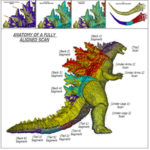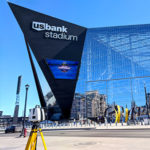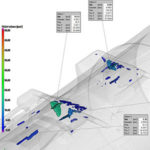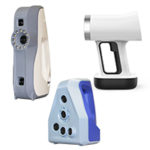Laser Design recently worked with a construction engineering company to provide long-range scanning services for an eight-story office building project. This long-range 3D laser scanning technology offers the most complete and accurate method for generating flatness reports, a key requirement across construction and architectural design. The Importance of Construction Floor Flatness Ensuring exact flatness in concrete floors is essential to maintaining structural efficiency and safety. Even the most minute error in floor flatness can disrupt day-to-day operations, inhibit future construction
How to Combine Data from Multiple Artec Scanners
Best of Both Worlds: Artec Eva and Space Spider If you own an Artec 3D scanner, then you’ll know each scanner is designed with a general range of part sizes in mind. For example, the Artec Eva and Leo are amazing at scanning large objects like furniture but are unable to capture small objects like jewelry. Conversely, the Space Spider has a resolution high enough to scan jewelry—but the small field of view makes it not suitable for scanning larger
Using the EasyTom CT Scanner and Geomagic® Design X™ to create a Parametric CAD Model from 3D CT Scan Data
One of our favorite things about 3D scanning is that it’s so versatile: this technology can be used to safely survey inaccessible areas, reverse engineer a prototype for 3D printing, produce as-built documentation, and much, much more. Today, we’re illustrating yet another valuable use of 3D scanners by taking a look at one of our recent projects. Below, we’ll walk through the process of parametric modeling from scan data, along with the key features used to create the geometry seen
Benefits of 3D Modeling and Why 2D Is Limited
With manufacturers across industries racing to increase productivity, every new technology and process could mean another step ahead of the competition. As a result of this push for more productive methods, many companies have made, or are making, the switch from 2D to 3D modeling—for a number of excellent reasons. Where 2D modeling limits and slows teams’ access to product design information, 3D solid modeling expands that access and understanding. This improved flow of information eliminates structural inefficiencies, human errors,
AEC 3D Scanning for Metal Panel Design
Architectural metal design and fabrication companies are tasked with designing, producing, and installing metal cladding panels on the exterior of buildings for protective and aesthetic finishes. These companies have a critical need for accurate and timely measurement of as-built conditions, but creating these records has traditionally been somewhat of a pain point for projects. Here’s the issue: as-built data facilitates the efficient design and manufacture of architectural elements. But this data, and the metal panels and other architectural elements created
How to Fix Parts that Move During 3D Scanning
King of the Problems If you’ve ever attended an Artec demonstration with Laser Design before, you’ve probably heard a common phrase describing what happens if you make a very mild mistake during scanning: “Fix it in post”. Originally meant for filmmakers who opt not to re-shoot but instead add special effects in post-production, the phrase takes on additional meaning in the 3D scanning world. Just as the film needs some love before reaching the silver screen, 3D scan data must
Maintaining and Maximizing the Portability of the Artec 3D Scanner
The rise of powerful handheld 3D scanners has dramatically changed the landscape where 3D scanning is able to be performed. No longer must parts be removed from location and shipped or brought to an office for 3D scanning on a stationary machine. The Artec Eva, Space Spider, and Leo handheld scanners represent some of the finest and most flexible portable scanners ever created and learning how to maximize their portability will be essential to mastering these scanners. Three key aspects
Laser Scanning Inaccessible Areas
Given the level of sophistication that technology has achieved in the 21st century, you would think that the architecture, engineering, and construction (AEC) industry would have already adopted an advanced solution across the board for projects involving inaccessible areas, such as wind turbines and telecommunication structures—but this isn’t the case. Traditional measuring methods require technicians to scale structures hundreds of feet tall, which creates challenges for both safety and efficiency. Fortunately, a solution does exist, and it’s growing in popularity.
Laser Design 3D Scan Portfolio on Sketchfab
Take Still Images to Interactive 3D If you have seen some of our previous blogs including Using Artec 3D Scanners for Heritage Preservation, 4 Possible Uses for Portable 3D Scanners and 3D Scanning a Glider, you probably noticed they have an interactive 3D model example. This interactive platform for providing a 3D viewer and portfolio, among a number of other tools and features, is from Sketchfab. With a subscriber base that continues to grow, Sketchfab is an outlet to explore,
3D Scanning and Reverse Engineering for 3D Printing Applications
3D printers use specific digital files to create three-dimensional physical parts and other objects. They are particularly useful for fabricating parts with complex or irregular geometry that might otherwise be difficult to construct, along with creating working samples of unique prototypes for testing, development, and manufacturing. Clearly, the applications for this technology are numerous—but before you can begin making use of 3D-printed parts and objects, you’ll need a digital version in a usable file format. While there are a variety
As-Built Documentation Using 3D Scanning: 5 Benefits of 3D Scanning for Design, Engineering and New Equipment Installation in Commercial Buildings
As-built documentation serves a variety of purposes throughout the design and construction process, but it’s particularly useful when it comes to renovating public spaces in buildings or upgrading manufacturing plants and mechanical spaces. Perhaps your company has just purchased a facility and didn’t receive documentation on the building. Or maybe you did receive documentation—and it’s 20 years out of date. Before you can reliably design and execute a renovation or upgrade, you’ll need to know what’s already there. As-built documentation
5 Advantages 3D Scanning Provides for Building Information Modeling
Efficiency is the name of the game when it comes to the architecture, engineering, and construction (AEC) industry. How can your team capture highly accurate data that can be manipulated to fill a variety of needs and utilized across these three disciplines—all on a tight timeline? The answer lies in Building Information Modeling (BIM), a process used for facilities management, design, maintenance, and planning for maintenance costs over time. BIM allows for a more efficient transfer of knowledge and coordination
The Benefits of Using a 3D Scanning Service Bureau
While they provide an immense amount of useful data and insights, 3D scanners are an investment. Perhaps you’re hoping to try out a 3D scanning technology before putting funds toward your own unit, or you’re interested in the expertise that a professional technician can provide. A 3D scanning service bureau can provide access to this useful technology for either a one-off project or ongoing services—generating high-resolution 3D scans that can be used for everything from reverse engineering to inspection and
Using Industrial Computed Tomography (CT) Technology to Expand Your 3D Measurement Capabilities
Capturing both the internal and external geometries of small or complex parts is no easy task, but it can provide significant advantages for designers, engineers, and manufacturers across a variety of industries. Luckily, metrology-grade computed tomography (CT) offers a reliable, nondestructive method for capturing high-resolution 3D data of complex and free-form parts—without the need for line-of-sight visual access. CT Scanning results include millions of data points that can be measured and analyzed to provide a number of key learnings. With
Using Artec 3D Scanners for Heritage Preservation
The practice of heritage preservation has been around for thousands of years, but the discipline has become more advanced in the past several decades. As technology and society’s understanding of what constitutes identity, culture, and heritage progresses, we’re seeing increased efforts to conserve, protect, and restore historic properties, landmarks, artwork, artifacts, and more. Many cities and states in the U.S. currently boast a heritage preservation commission dedicated to protecting key pieces of local and national history. In the last three
4 Possible Uses for Portable 3D Scanners
Portable 3D scanners have made the process of 3D scanning more accessible than ever before. Instead of having to deal with bulky stationary units, 3D scanning technicians and operators can complete a scan wherever their subject lies, whether that be in the field or the lab. Industries from aerospace to law enforcement are constantly discovering new uses for this type of equipment, and we couldn’t be happier to assist this technology in taking off. Because the applications of this equipment
Demystifying the 3D Scanning Process
If you’ve seen a 3D scanner in action, you know that scans can be accomplished quickly and used to create detailed digital models of just about any object. But moving a scanner around a subject is a deceptively simple act—there’s a lot more going on beneath the surface. Whether you’re thinking of purchasing an Artec 3D scanner or you’re interested in terrestrial scanning services for a large project, we’re here to provide a more in-depth look at exactly what happens
5 Interesting Uses of 3D Scanning
In the last 30 years, Laser Design has participated in, facilitated, and supplied equipment to a number of 3D scanning projects. Our experiences in the field and in the laboratory have shown us the sheer breadth of this technology and the range of objectives it can accomplish. Would you believe that our scanners have passed over everything from a live lobster to the President of the United States? With the right scanner and 3D scanning software, even novices can create
3D Scanning a Glider With the Artec Leo and Ray
Laser Design recently worked with a commercial glider operation, Cross Country Soaring, to perform a complete 3D scan of one of their Grob 103 Twin II gliders. Cross Country Soaring is based out of Minneapolis, and the 3D scanning was performed at a hangar at a nearby airport. How Do You 3D Scan a Glider? To complete the project, our 3D scanning experts used a combination of the Artec Ray long range 3D scanner and the Artec Leo handheld 3D
Top 10 Educational Departments Utilizing 3D Scanning
Over the past 10 years, 3D scanning has garnered tremendous mainstream attention. What was once a niche, specialized industry is now something that most everyone with access to the internet can see and read about—and, with the help of 3D scanners and printers, experience for themselves. The barriers to entry for the 3D world have never been lower. With every passing year, more and more businesses and organizations will rely on and leverage 3D scanning technologies to generate assets for
5 Essential Tools to Master in Artec Studio Software
For all the glory that the Artec 3D portable scanners receive, we can’t forget that Artec Studio 3D scanning software is the “secret sauce” that makes the whole process work so well. Built to take your 3D scanning projects from scan to polygon-model-export, Artec Studio contains a simple and intuitive core workflow, as well as myriad branches of processing tools and elements that help you handle all of your unique and interesting scanning projects. Mastery of these tools takes an
Which Portable 3D Scanner Should I Buy?
Whether you need a solution for new product design, 3D printing, or visualization and simulation, 3D scanning can deliver high-quality results. Portable 3D scanners—whether handheld or stationary—offer a higher degree of control and more maneuverability than their bulky counterparts, making them a popular choice across a range of industries. But with a variety of providers and a plethora of devices on the market, how do you choose the right portable 3D scanner for your needs? At Laser Design, a brand
Digging for the truth about the Kensington Runestone with Artec Eva and Space Spider
Summary Two archaeologists hosting the TV show America’s Lost Vikings decided to use color 3D scanning to try and determine the true age of this controversial artifact. The Goal To precisely scan in under one hour a large runestone, and then process the scans into an extremely detailed 3D model which they would then use for depth measurement and comparison of the engraved runes. Tools Used Artec Eva & Space Spider For more than a century now, historians and scientists























